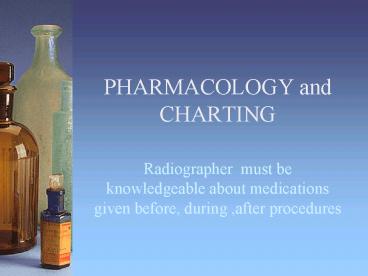PHARMACOLOGY and CHARTING - PowerPoint PPT Presentation
1 / 21
Title:
PHARMACOLOGY and CHARTING
Description:
Instructs preparation and use of medicine or device ... Sedatives and tranquilizers ( Valium, Versed) Antagonists. Drug binds with receptor sites ... – PowerPoint PPT presentation
Number of Views:96
Avg rating:3.0/5.0
Title: PHARMACOLOGY and CHARTING
1
PHARMACOLOGY and CHARTING
- Radiographer must be knowledgeable about
medications given before, during ,after procedures
2
OTC and Prescription
- What is the difference between OTC drugs and
prescription drugs? - Over-the-counter drugs
- treats condition does not require the direct
supervision of doctor - proven to be reasonably safe and well-tolerated
- Little chance for abuse
- Benadryl and Claritin
3
- Prescription is a legal document
- Instructs preparation and use of medicine or
device - Indicates prescriber takes responsibility for
care and outcomes to patient
4
- Standing Order
- Written directions for specific med. or
procedure - Used under specific conditions in order
- Name, amount, time and pt instruction sheet
- Cathartic (strong laxative)
5
Drug Action
- Agonist
- Drug binds to receptors on specific cells or
tissues - Produces an effect
- Sedatives and tranquilizers ( Valium, Versed)
6
- Antagonists
- Drug binds with receptor sites
- Prevent an action from happening
- Blocking drugs
- Counteracts effects
- Needed to reverse respiratory depression
7
Drug Classification
- System used to identify drugs
- Classified by Name, Action, Prescription/
Non-prescription - Chemical name- birth of drug
- Generic Name- becomes available, now can be made
by several companies - Trade or Brand name- company name ( given by
manufacturer)
8
Terms
- Pharmacology
- Pharmacokinetics
- Intravenous Therapy
- Conscious Sedation
9
- Blood Brain Barrier
- Hypertonic Solution
- Hypotonic Solution
- Osmolality
10
Routes
- Local Medication
- Specific site
- Route- direct injection
- Purpose- reduction of sensation in surrounding
area - Used before procedure
11
Routes
- Systemic Medications
- Wide variety of effects
- Used before, during and after procedure and to
counter act during emergencies - 4 Major Routes of Administration
- Oral, rectal, sublingual, parenteral(
administered by route other than GI tract,
usually by injection)
12
Parenteral Medication Administration
- Considered invasive- standard precautions used
- Intravenousvein
- Intradermaldermis between 2 layers of skin
- Intrathecalsubdural,subarachnoid
- Subcutaneous under the skin
- Intramuscular--muscle
13
Drug Administration
- There are 6 rights of drug administration
- Right patient
- Right drug
- Right dosage
- Right time
- Right route
- Right documentation
14
Frequently Used Medications
- 1. Cardiac Medications (Antiarrhythmics)
- Modify the rhythm or BP in the heart
- Usually less stable and acute problems can
happen sooner - 2. Anticoagulant
- Blood thinner
- Careful of fall potential
15
- 3. Analgesic
- Medications prescribed most
- Relieve pain w/o LOC
- Can be respiratory depressant
- 4. Antidepressants
- 5. Chemotherapy Agents
- Care must be taken so healthcare worker does not
come in contact with these- carcinogens
16
- 6. Sedatives and Tranquilizers
- 7. Paralytic Agents
- Muscle relaxant
- All muscles in body temporarially paralyzed
- Pt. still concious
- Succinylchlorine Chloride
- 8. Antimcobials- antiseptics for skin prep
- 9. Anticonvulsants- for seizure patients
17
Reaction Treatments
- Allergic Reaction Treatments
- Diphenhydramine (Benadryl) antihistamine
- Given before exam for prevention
- Oral. IM or IV if patient has reaction
- Cortisone given also
- Acute reactions
- Epinephrine (Adrenalin)
- Given subcutaneously, IM or IV
- Controls edema, shock and respiratory distress
18
- No response to theseMethylprednisolone
(Solu-Medrol) by IV - Corticosteroid acts as anti-inflammatory
- Reduces edema of tracheobronchial tree
- Trying to prevent respiratory arrest
- Provided as powder and a fluid in 2 separate
vials - Must be mixed together before administration
19
CHARTING
- Patients medical chart is medical record that
belongs to hospital - Accurate, chronological history of events
- All healthcare workers rely on its input and
accuracy
20
- Charts Arrangement
- Summary sheet
- Legal consents and advanced directions
- History and physical exam sheet
- Problem list
- Physicians orders, progress notes
- Graphic records, lab results and test results
- Consultations
21
Charting Medications
- If medication given, must be documented
- Information required
- Time of day
- Name of drug
- Dosage
- Route of administration
- ID of person who charted it
- ( not initials)
- Cross out mistakesdo not erase





![[PDF] Pharmacology 11th Edition Android PowerPoint PPT Presentation](https://s3.amazonaws.com/images.powershow.com/10085905.th0.jpg?_=20240726121)

























